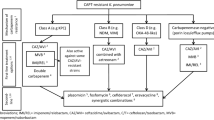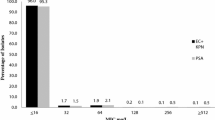Abstract
Antimicrobial resistance is a growing problem among upper respiratory tract pathogens. Resistance to β-lactam drugs among Streptococcus pneumoniae, Haemophilus influenzae, and Streptococcus pyogenes is increasing. As safe and well-tolerated antibiotics, macrolides play a key role in the treatment of community-acquired upper respiratory tract infections (RTIs). Their broad spectrum of activity against gram-positive cocci, such as S. pneumoniae and S. pyogenes, atypical pathogens, H. influenzae (azithromycin and clarithromycin), and Moraxella catarrhalis, has led to the widespread use of macrolides for empiric treatment of upper RTIs and as alternatives for patients allergic to β-lactams. Macrolide resistance is increasing among pneumococci and recently among S. pyogenes, and is associated with increasing use of the newer macrolides, such as azithromycin. Ribosomal target modification mediated by erm(A) [erm(TR)] and erm(B) genes and active efflux due to mef(A) and mef(E) are the principal mechanisms of resistance in S. pneumoniae and S. pyogenes. Recently, ribosomal protein and RNA mutations have been found responsible for acquired resistance to macrolides in S. pneumoniae, S. pyogenes, and H. influenzae. Although macrolides are only weakly active against macrolide-resistant streptococci species producing an efflux pump (mef) and are inactive against pathogens with ribosomal target modification (erm), treatment failures are uncommon. Therefore, macrolide therapy, for now, remains a good alternative for treatment of upper RTIs; however, continuous monitoring of the local resistance patterns is essential.
Similar content being viewed by others
References and Recommended Reading
Bozdogan B, Appelbaum PC: Macrolide resistance in streptococci and Haemophilus influenzae. Clin Lab Med 2004, 24:455–475. This article analyzes macrolide-resistance mechanisms and their worldwide distributions in S. pneumoniae, S. pyogenes, and H. influenzae.
Zhanel GG, Dueck M, Hoban DJ, et al.: Review of macrolides and ketolides: focus on respiratory tract infections. Drugs 2001, 61:443–498. This is an excellent review focusing on the mode of macrolide action and mechanisms of resistance.
Zhanel GG, Palatnick L, Nichol KA, et al.: Antimicrobial resistance in respiratory tract Streptococcus pneumoniae isolates: results of the Canadian Respiratory Organism Susceptibility Study, 1997 to 2002. Antimicrob Agents Chemother 2003, 47:1867–1874. This article describes the recent trends in antimicrobial resistance, including macrolides, among Canadian clinical isolates of S. pneumoniae.
Zhanel GG, Palatnick L, Nichol KA, et al.: Antimicrobial resistance in Haemophilus influenzae and Moraxella catarrhalis respiratory tract isolates: results of the Canadian Respiratory Organism Susceptibility Study, 1997 to 2002. Antimicrob Agents Chemother 2003, 47:1875–1881. This article describes the recent trends in antimicrobial resistance, including macrolides, among Canadian clinical isolates of H. influenzae.
Betriu C, Casado MC, Gomez M, et al.: Incidence of erythromycin resistance in Streptococcus pyogenes: a 10-year study. Diagn Microbiol Infect Dis 1999, 33:255–260. This paper evaluates the worldwide evolution of resistance to various antimicrobials in S. pyogenes.
Granizo JJ, Aguilar L, Casal J, et al.: Streptococcus pyogenes resistance to erythromycin in relation to macrolide consumption in Spain (1986-1997). J Antimicrob Chemother 2000, 46:959–964.
Katz KC, McGeer AJ, Duncan CL, et al.: Emergence of macrolide resistance in throat culture isolates of group A streptococci in Ontario, Canada, in 2001. Antimicrob Agents Chemother 2003, 47:2370–2372. This study describes the link between the increased use of the newer macrolides, azithromycin and clarithromycin, and the emergence of macrolide resistance among Canadian isolates of S. pyogenes.
Reinert RR, Lutticken R, Bryskier A, Al-Lahham A: Macrolideresistant Streptococcus pneumoniae and Streptococcus pyogenes in the pediatric population in Germany during 2000–2001. Antimicrob Agents Chemother 2003, 47:489–493.
Szczypa K, Sadowy E, Izdebski R, Hryniewicz W: A rapid increase in macrolide resistance in Streptococcus pyogenes isolated in Poland during 1996–2002. J Antimicrob Chemother 2004, 54:828–831.
Cascone C, Santagati M, Noviello S, et al.: Macrolide-resistance genes in clinical isolates of Streptococcus pyogenes. Microb Drug Resist 2002, 8:129–132.
Hoban DJ, Wierzbowski AK, Nichol K, Zhanel GG: Macrolideresistant Streptococcus pneumoniae in Canada during 1998–1999: prevalence of mef(A) and erm(B) and susceptibilities to ketolides. Antimicrob Agents Chemother 2001, 45:2147–2150.
Bingen E, Bidet P, Mihaila-Amrouche L, et al.: Emergence of macrolide-resistant Streptococcus pyogenes strains in French children. Antimicrob Agents Chemother 2004, 48:3559–3562.
Ban N, Nissen P, Hansen J, et al.: The complete atomic structure of the large ribosomal subunit at 2.4 A resolution. Science 2000, 289:905–920.
Clancy J, Petitpas J, Dib-Hajj F, et al.: Molecular cloning and functional analysis of a novel macrolide-resistance determinant, mef(A), from Streptococcus pyogenes. Mol Microbiol 1996, 22:867–879.
Amezaga MR, Carter PE, Cash P, McKenzie H: Molecular epidemiology of erythromycin resistance in Streptococcus pneumoniae isolates from blood and noninvasive sites. J Clin Microbiol 2002, 40:3313–3318.
Del Grosso M, Iannelli F, Messina C, et al.: Macrolide efflux genes mef(A) and mef(E) are carried by different genetic elements in Streptococcus pneumoniae. J Clin Microbiol 2002, 40:774–778.
Gay K, Stephens DS: Structure and dissemination of a chromosomal insertion element encoding macrolide efflux in Streptococcus pneumoniae. J Infect Dis 2001, 184:56–65.
Pozzi G, Iannelli F, Oggioni MR, et al.: Genetic elements carrying macrolide efflux genes in streptococci. Curr Drug Targets Infect Disord 2004, 4:203–206.
Oster P, Zanchi A, Cresti S, et al.: Patterns of macrolide resistance determinants among community-acquired Streptococcus pneumoniae isolates over a 5-year period of decreased macrolide susceptibility rates. Antimicrob Agents Chemother 1999, 43:2510–2512.
Seppala H, Skurnik M, Soini H, et al.: A novel erythromycin resistance methylase gene (ermTR) in Streptococcus pyogenes. Antimicrob Agents Chemother 1998, 42:257–262.
Hasenbein ME, Warner JE, Lambert KG, et al.: Detection of multiple macrolide- and lincosamide-resistant strains of Streptococcus pyogenes from patients in the Boston area. J Clin Microbiol 2004, 42:1559–1563.
Kataja J, Huovinen P, Seppala H: Erythromycin resistance genes in group A streptococci of different geographical origins. The Macrolide Resistance Study Group. J Antimicrob Chemother 2000, 46:789–792. The prevalence of macrolide resistance genes mef(A), erm(B), and erm(TR) in eight different European countries and some centers in North and South America is examined in this study.
Tait-Kamradt A, Davies T, Appelbaum PC, et al.: Two new mechanisms of macrolide resistance in clinical strains of Streptococcus pneumoniae from Eastern Europe and North America. Antimicrob Agents Chemother 2000, 44:3395–3401.
Tait-Kamradt A, Davies T, Cronan M, et al.: Mutations in 23S rRNA and ribosomal protein L4 account for resistance in pneumococcal strains selected in vitro by macrolide passage. Antimicrob Agents Chemother 2000, 44:2118–2125.
Zhanel GG, Hisanaga T, Nichol K, et al.: Ketolides: an emerging treatment for macrolide-resistant respiratory infections, focusing on S. pneumoniae. Expert Opin Emerg Drugs 2003, 8:297–321.
Arpin C, Canron MH, Noury P, Quentin C: Emergence of mef(A) and mef(E) genes in beta-haemolytic streptococci and pneumococci in France. J Antimicrob Chemother 1999, 44:133–134.
Montanari MP, Mingoia M, Cochetti I, Varaldo PE: Phenotypes and genotypes of erythromycin-resistant pneumococci in Italy. J Clin Microbiol 2003, 41:428–431.
Roberts MC, Sutcliffe J, Courvalin P, et al.: Nomenclature for macrolide and macrolide-lincosamide-streptogramin B resistance determinants. Antimicrob Agents Chemother 1999, 43:2823–2830.
Seppala H, Nissinen A, Yu Q, Huovinen P: Three different phenotypes of erythromycin-resistant Streptococcus pyogenes in Finland. J Antimicrob Chemother 1993, 32:885–891.
Bingen E, Leclercq R, Fitoussi F, et al.: Emergence of group A Streptococcus strains with different mechanisms of macrolide resistance. Antimicrob Agents Chemother 2002, 46:1199–1203.
Santagati M, Iannelli F, Oggioni MR, et al.: Characterization of a genetic element carrying the macrolide efflux gene mef(A) in Streptococcus pneumoniae. Antimicrob Agents Chemother 2000, 44:2585–2587.
Adam D, Scholz H: Five days of erythromycin estolate versus ten days of penicillin V in the treatment of group A streptococcal tonsillopharyngitis in children. Pharyngitis Study Group. Eur J Clin Microbiol Infect Dis 1996, 15:712–717.
Adelglass J, Jones TM, Ruoff G, et al.: A multicenter, investigator-blinded, randomized comparison of oral levofloxacin and oral clarithromycin in the treatment of acute bacterial sinusitis. Pharmacotherapy 1998, 18:1255–1263.
Amin NM, Breadon G: An open-label, noncomparative study to evaluate the efficacy, safety, and tolerability of azithromycin in the treatment of patients with acute sinusitis. Clin Ther 1995, 17:701–707.
Arguedas A, Loaiza C, Rodriguez F, et al.: Comparative trial of 3 days of azithromycin versus 10 days of clarithromycin in the treatment of children with acute otitis media with effusion. J Chemother 1997, 9:44–50.
Aronovitz G: A multicenter, open label trial of azithromycin vs. amoxicillin/clavulanate for the management of acute otitis media in children. Pediatr Infect Dis J 1996, 15:S15-S19.
Clement PA, de Gandt JB: A comparison of the efficacy, tolerability and safety of azithromycin and co-amoxiclav in the treatment of sinusitis in adults. J Int Med Res 1998, 26:66–75.
Cremer J, Wallrauch C, Milatovic D, Braveny I: Azithromycin versus cefaclor in the treatment of pediatric patients with acute group A beta-hemolytic streptococcal tonsillopharyngitis. Eur J Clin Microbiol Infect Dis 1998, 17:235–239.
Esposito S, De Ritis G, D’Errico G, et al.: Clinical comparison of cefaclor twice daily versus amoxicillin-clavulanate or erythromycin three times daily in the treatment of patients with streptococcal pharyngitis. Clin Ther 1998, 20:72–79.
Hashiba M, Baba S: Efficacy of long-term administration of clarithromycin in the treatment of intractable chronic sinusitis. Acta Otolaryngol 1996, 525(Suppl):73–78.
Kearsley NL, Campbell A, Sanderson AA, et al.: Comparison of clarithromycin suspension and amoxycillin syrup for the treatment of children with pharyngitis and/or tonsillitis. Br J Clin Pract 1997, 51:133–137.
Khurana CM: A multicenter, randomized, open label comparison of azithromycin and amoxicillin/clavulanate in acute otitis media among children attending day care or school. Pediatr Infect Dis J 1996, 15:S24-S29.
Marchisio P, Principi N, Sala E, et al.: Comparative study of once-weekly azithromycin and once-daily amoxicillin treatments in prevention of recurrent acute otitis media in children. Antimicrob Agents Chemother 1996, 40:2732–2736.
McCarty J: A multicenter, open label trial of azithromycin for the treatment of children with acute otitis media. Pediatr Infect Dis J 1996, 15:S10-S14.
McCarty JM: Comparative efficacy and safety of cefprozil versus penicillin, cefaclor and erythromycin in the treatment of streptococcal pharyngitis and tonsillitis. Eur J Clin Microbiol Infect Dis 1994, 13:846–850.
McLinn S: A multicenter, double blind comparison of azithromycin and amoxicillin/clavulanate for the treatment of acute otitis media in children. Pediatr Infect Dis J 1996, 15:S20-S23.
Pacifico L, Scopetti F, Ranucci A, et al.: Comparative efficacy and safety of 3-day azithromycin and 10-day penicillin V treatment of group A beta-hemolytic streptococcal pharyngitis in children. Antimicrob Agents Chemother 1996, 40:1005–1008.
Principi N: Multicentre comparative study of the efficacy and safety of azithromycin compared with amoxicillin/clavulanic acid in the treatment of paediatric patients with otitis media. Eur J Clin Microbiol Infect Dis 1995, 14:669–676.
Rodriguez AF: An open study to compare azithromycin with cefaclor in the treatment of children with acute otitis media. J Antimicrob Chemother 1996, 37(Suppl C):63–69.
Schaad UB, Heynen G: Evaluation of the efficacy, safety and toleration of azithromycin vs. penicillin V in the treatment of acute streptococcal pharyngitis in children: results of a multicenter, open comparative study. The Swiss Tonsillopharyngitis Study Group. Pediatr Infect Dis J 1996, 15:791–795.
Scholz H, Noack R: Multicenter, randomized, double-blind comparison of erythromycin estolate versus amoxicillin for the treatment of acute otitis media in children. AOM Study Group. Eur J Clin Microbiol Infect Dis 1998, 17:470–478.
Venuta A, Laudizi L, Beverelli A, et al.: Azithromycin compared with clarithromycin for the treatment of streptococcal pharyngitis in children. J Int Med Res 1998, 26:152–158.
Pavlopoulou J, Leotsacos P, Sereti E, et al.: Randomized controlled study of clarithromycin versus cefaclor suspensions in the treatment of acute otitis media in children. J Chemother 1995, 7(Suppl 4):150–153.
O’Doherty B: Azithromycin versus penicillin V in the treatment of paediatric patients with acute streptococcal pharyngitis/tonsillitis. Paediatric Azithromycin Study Group. Eur J Clin Microbiol Infect Dis 1996, 15:718–724.
Rzeszutek M, Wierzbowski A, Hoban DJ, et al.: A review of clinical failures associated with macrolide-resistant Streptococcus pneumoniae. Int J Antimicrob Agents 2004, 24:95–104. This is an excellent review describing the macrolide treatment failure associated with macrolide-resistant S. pneumoniae.
Author information
Authors and Affiliations
Rights and permissions
About this article
Cite this article
Wierzbowski, A.K., Hoban, D.J., Hisanaga, T. et al. The use of macrolides in treatment of upper respiratory tract infections. Curr Infect Dis Rep 7, 175–184 (2005). https://doi.org/10.1007/s11908-005-0031-z
Issue Date:
DOI: https://doi.org/10.1007/s11908-005-0031-z




